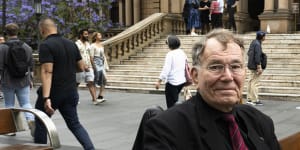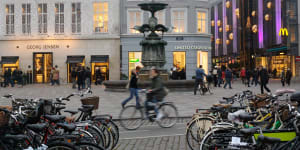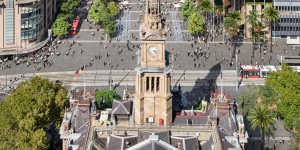The urbanist,author and international expert on creating walkable cities that put people first and cars last,87-year-old Gehl visited Sydney recently to see the 2019 pedestrianisation and greening of George Street that his team recommended.

Jan Gehl outside Sydney Town Hall.Janie Barrett
“It was not very good,” he said of Sydney back in 2006. “All the clutter,the obstacles on the sidewalks,the noise,and of course,the Monorail.”
He was also in Sydney to throw the weight of his international reputation,earned by transforming parts of New York,London,Melbourne and Buenos Aires,behind Lord Mayor Clover Moore’s push to realise their grand plan for Sydney that includes a public plaza to be called Town Hall Square. It’s been delayed until 2033.
“The area between here and[St Andrew’s Cathedral] is very,very poor,and it’s been that way for all the 16 years I have been visiting,” Gehl said.
He continues to lobby for his original dream of banning cars from crossing George Street,preferably by giving them free access to the cross city tunnel,he said.
He also wants to remove most cars from the city,ban street parking,except ride share vehicles,and ban parking in high-rise blocks near public transport.
When Gehl started working with the City of Sydney,his team timed how long it took to walk across the city. They found more than 50 per cent of walking time was spent waiting for traffic lights to turn green,he told a lecture at University of Technology Sydney during his visit.
He’s appalled Sydney’s pedestrians need to ask for “consent” to cross city roads,a very British idea,he says. He wants continuous footpaths,similar to those in Denmark,that are the same level across a road and the footpath. Motorists will have to wait for pedestrians.
Speaking outside Town Hall Gehl said he was “hilariously happy to see George Street finished” particularly given his insider knowledge.

Copenhagen,DenmarkWade Laube
Not everything had turned out the way Gehl wanted. He had wanted the light rail carriages and platforms to be much shorter than they are.
But the changes he approved of included George Street’s widened footpaths,adding 20,000 of public space,and added trees,making the city’s oldest main road feel more like a European boulevard.
Gehl,a people watcher since visiting Italy as a young urban planner,headed towards the benches near Town Hall’s steps to snap a photo of a woman doing yoga.
This kind of daily life in the city marked a return to the way cities operated before cars. “There were spaces for people,for life,you walked,you had ceremonies,you crowned the kings and beheaded the civilians. Everything happened in the spaces,” Gehl said.

An artist’s impression of the future Town Hall Square.Supplied
“What makes me happy is to see a completely different ambience in the city. It is more people oriented … more attractive and accessible,” Gehl said.
When he tried to find a spot to sit,every bench was full.
“A good city is like a good party - people stay longer than really necessary because they are enjoying themselves,” Gehl said. “If you see a city with many children and many old people using the city’s public spaces it’s a sign that it’s a good quality place for people.”
His 2007 report Public Spaces and Public Life found the city lacked character,streets were dominated by traffic,and pedestrian numbers were low,and vehicle numbers high.

Lord Mayor Clover Moore has praised the contribution of Jan Gehl to Sydney.Wolter Peeters
Gehl’s team calculated that there were 60 to 90 per cent fewer pedestrians on George Street than similar places in smaller cities,including Rundle Mall in South Australia.
But visitor numbers are improving,said a City of Sydney spokesperson. The use of public transport - measured by Opal card usage - in the CBD on weekdays has returned to 94 per cent of pre-pandemic levels compared with 67 per cent in October 2022.
Weekend public transport use in the Sydney CBD is 20 per cent to 30 per cent higher than before the pandemic. The biggest increase is on Sundays,suggesting visitors are coming for culture and recreation.
Moore told a reception recently that Gehl’s contribution to Sydney was as significant as that of Jorn Utzon,the architect of the Opera House. His plan had been “a once-in-a-lifetime opportunity to realise Sydney’s potential as a green,global and connected city;and a city for people”.
“We have come a long way since 2007 when Jan Gehl said Sydney had turned its back on the harbour,and that it was at breaking point,unable to cope with traffic volumes and gradually being choked in fumes and noise,” she said.
Start the day with a summary of the day’s most important and interesting stories,analysis and insights..